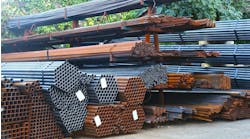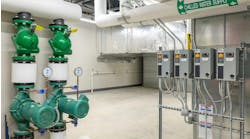Latest from Home
Sponsored
NEW YORK — Just this May, the Bank of America Tower, a 55-story office building here at One Bryant Park LLC, comprised of owners The Durst Organization and Bank of America N.A., received U.S. Green Building Council’s LEED Platinum certification for the core and shell of the building. The 2.1-million square foot skyscraper, which is the first in the world to receive Platinum certification, has its own 4.6-megawatt co-generation plant, water conserving systems and an under-floor ventilation system, which all played a role in garnering LEED Platinum certification.
“With its energy-efficient co-gen plant, its ice storage capabilities, its graywater- and stormwater-retention systems, and other sustainable features, this is a groundbreaking achievement of which we can all be proud,” said Douglas Durst, co-president of The Durst Organization.”
Co-generation plant
According to project managers at Tishman Construction Corp., the project’s construction management firm, the 4.6-megawatt on-site co-generation (combined heat and power) system will provide 65% of the building’s annual electricity requirements, reducing daytime peak electricity demand by 30%. Only a fraction of the energy contained in the fuel is lost since it is used to produce electricity and to simultaneously heat the building.
The co-generation plant generates most of the heating energy for the building, thus the waste heat from co-generation is used to heat the building during the winter months and cool it during the summer months via absorption chillers. When heat is needed, the steam produced from the heat in the turbine exhaust offsets the need for boilers. Plus, additional fuel is burned in the exhaust duct of the gas turbine to produce a greater amount of steam to meet the building needs.
The concept of the plant is to use the waste heat differently, so instead of recovering the heat to produce steam to make electricity in a steam turbine, the steam is used to meet the heating and cooling needs of the building, according to Tishman Construction project managers.
During winter months, when the building needs to be heated, the low-pressure steam is used for heat, and with the help of a reinforcing burner section, it will provide 100% of the building’s winter heating needs while the generator simultaneously provides a large percentage of its electrical needs. During summer months, steam will be used to produce chilled water via absorption chiller technology. The co-gen plant will still use as much of the energy that was originally contained in the fuel as possible. A portion of the chilled water will be used to cool the air within the co-generation plant, and the remainder will be utilized by the building to offset the use of electrically-driven chillers.
On warm nights, the electric power will help create ice in the building’s ice storage system, which will provide approximately 25% of the building’s annual cooling requirements, reducing daytime peak loads on the city’s electricity grid. During the day, ice will be melted to supplement the cooling system.
Water conservation
Besides conserving energy on site, water will also be saved. A savings of approximately 7.7 million gallons of water per year will be achieved through a variety of water efficient systems, such as graywater treatment and re-use, waterless urinals and low-flow plumbing fixtures.
Waterless urinals alone will save 3.4 million gallons of potable water annually. Plus, almost zero stormwater will be discharged to the city’s sewer system.
Another sustainable feature of the building is that its foundation is the deepest in midtown Manhattan, so approximately 5,000 gallons of groundwater per day is collected from neighboring sites. This groundwater is captured and reused in the graywater system. The graywater system also captures and re-uses rain as well as the cooling coil condensate and sink water generated in the building. Graywater collection tanks are staged throughout the building, taking advantage of gravity to transport graywater.
Indoor air quality
According to Tishman Construction project managers, the under-floor ventilation system was chosen because it eliminates overhead ductwork, it keeps the heating/cooling to the lower levels in the building, and floor vents are controllable to adjust the air volume. The air filtration system also removes 95% of particulates, and most outside air is taken in at 800-ft. above street level where air is usually cleaner. At a higher elevation the intake of car exhaust and other ground level pollutants is reduced.
The under-floor ventilation system also allows for individual climate control through in-floor air diffusers. Floor-by-floor air handling units provide more even, efficient and healthy cooling and fresh air.
There is also a continuous air monitoring system tracking CO2, CO, volatile organic compounds (VOCs) and small particulates, ensuring high quality ventilation air.
Candace Roulo
Candace Roulo, senior editor of CONTRACTOR and graduate of Michigan State University’s College of Communication Arts & Sciences, has 15 years of industry experience in the media and construction industries. She covers a variety of mechanical contracting topics, from sustainable construction practices and policy issues affecting contractors to continuing education for industry professionals and the best business practices that contractors can implement to run successful businesses.


